Disclaimer: I’m limited to what I can capture in youtube trailer screenshots, and publicity photos in various articles. I’ll try to go back and add more when the movie starts streaming. Also, I can’t seem to insert French accents here at home where I’m writing; I managed it on my work computer so I’ll go back and make those edits when I’m back at work.
Did you find it hard to switch back and forth between time frames in the movie? It may help to notice (if you haven’t yet seen it, or you plan to back or watch it streaming) that the lighting, and clothing, have very different looks in each period. The present, when everyone is grown up, is filmed in very cold light, and there are darker clothes overall–many in tones of blue, gray, and black.
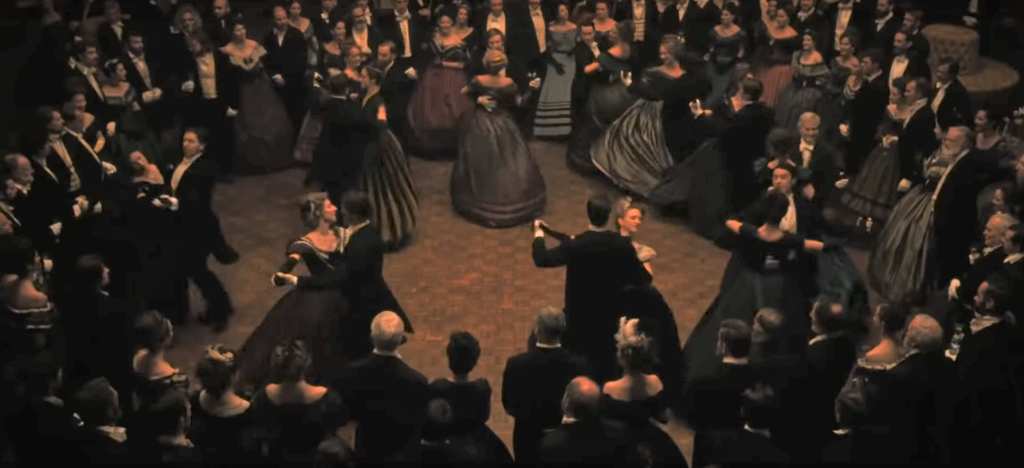
The flashbacks to childhood are filmed in warm light and more color, lending them an emotional warmth and nostalgic glow. Compare the ball scenes for a dramatic illustration of this. (The outdoor scenes in Paris are more cheerful, but overall there’s a discernible difference.)

So let’s look at the later costumes. We are now in the very late 1860s or just about 1870: it’s not completely clear when, but the differences are not huge: below, you can see that between 1869 and 1870, the silhouette has changed noticeably but not hugely. Amy is in Paris with a wardrobe funded by her rich aunt: yes, she will be wearing the latest silhouette. Ideally, we would be able to date her dresses and they’d have a consistent, easy-to-date style. (This is PARIS. This is AMY.)
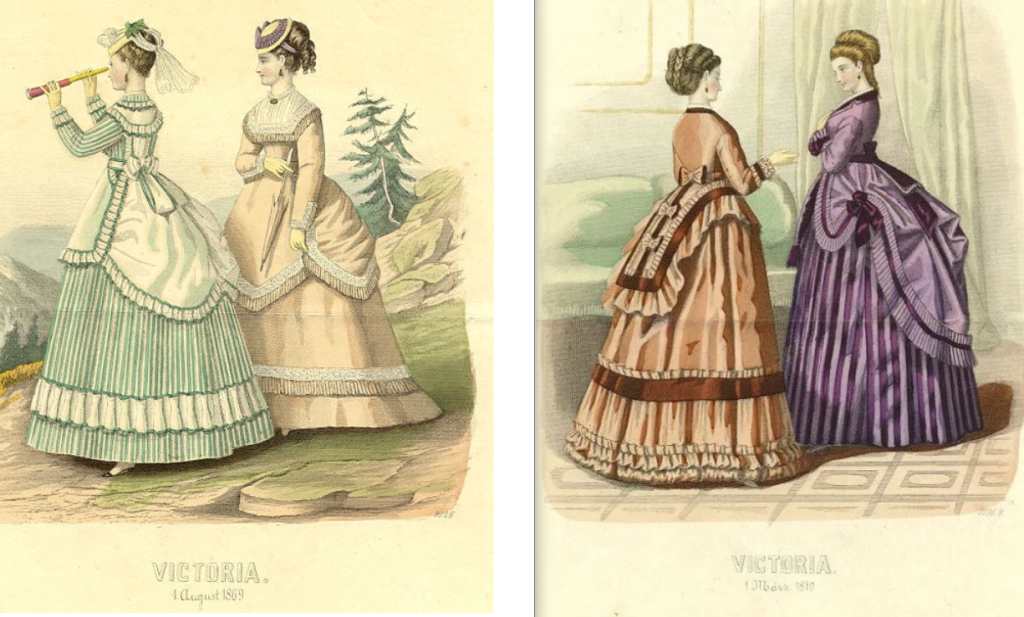
There’s a HUGE difference, however, from the early to mid 1860s when skirts were full all around; now they are flat in front and full in back.
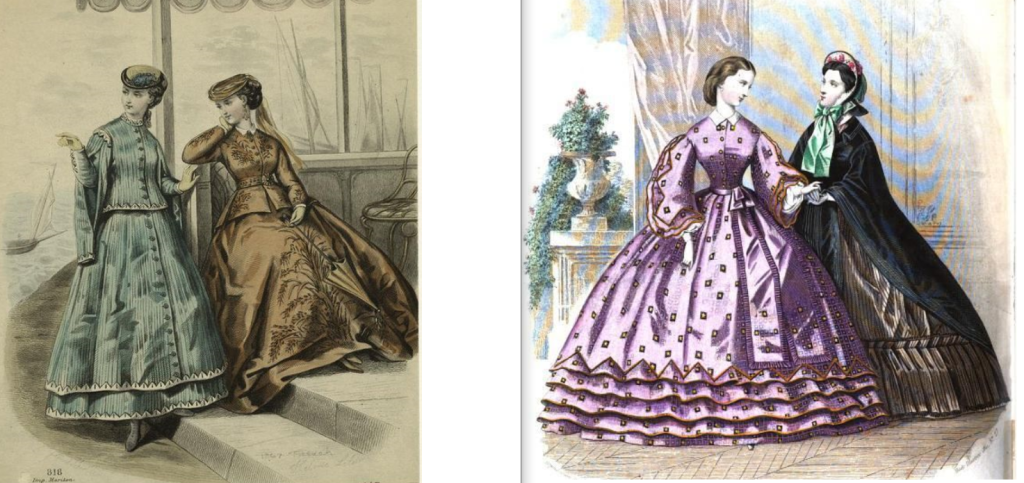
Amy is the main focus of fashion interest in this half, and she shows, rather inconsistently, this shift in the fashionable silhouette. Her signature color is blue, which happens to have been a very popular color at the time. We see a lot of one blue silk taffeta skirt similar to the color of the dress below, and a lighter, probably cotton skirt.

Amy’s blue skirts still have the earlier 60s roundness, when they should be flat.
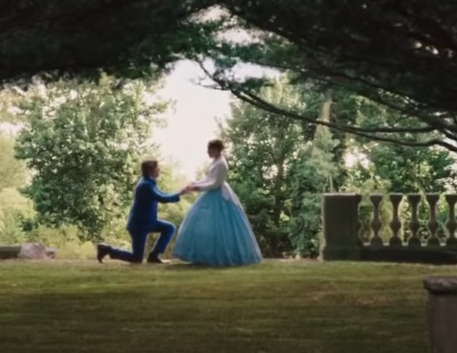
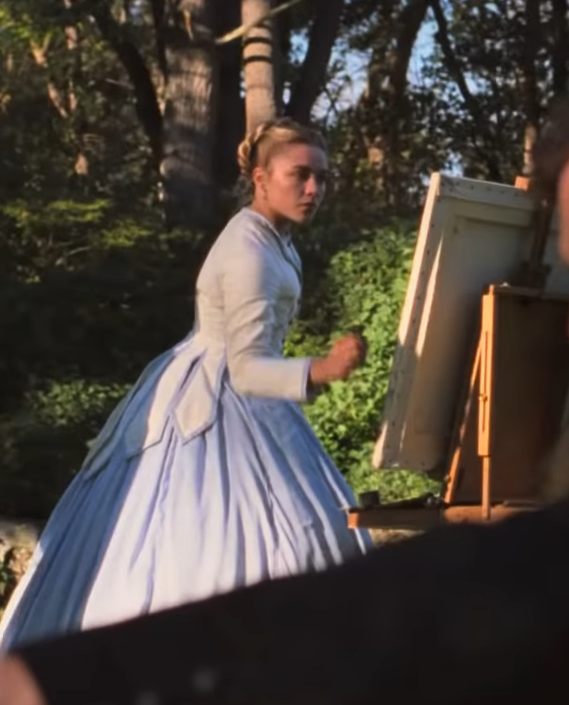
The tabbed overskirt, though, is a very nice late 60s touch: see a similar overskirt in the plate below:

Can we pause and give credit for the fact that the scene Amy’s class is painting is a more fully clothed variation of Manet’s art-world-shaking Dejeuner Sur l’Herbe?
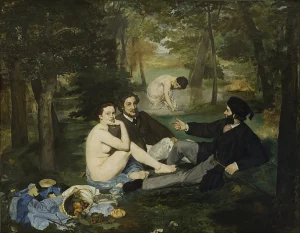
Painted in 1862-3 and rejected by the Paris Salon in 1863, it was one of the paintings that launched the Impressionist movement (that’s a vast oversimplification; I don’t want to digress too much). It’s great that Gerwig made the connection, realizing just what kind of painting Amy would be seeing in Paris (although I wonder whether Aunt March would have approved of this new fad of open-air painting, I love it, let’s go with it).

I love this outfit; the closeups show a nice textured stripe to this cotton top, very good for the period, when dimity and Marseilles woven cottons were supremely practical and fashionable summer wear. The blue and white is fresh and summery. Here’s a similar treatment from the John Bright collection:
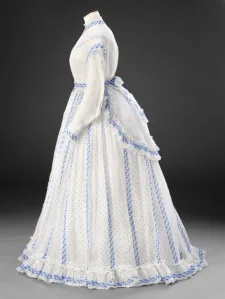
Gerwig said in an interview that she looked at Monet’s paintings for Amy’s look. It does remind me of his paintings of women in a garden–dated 1866-7 (and can I point out they are flat in front).
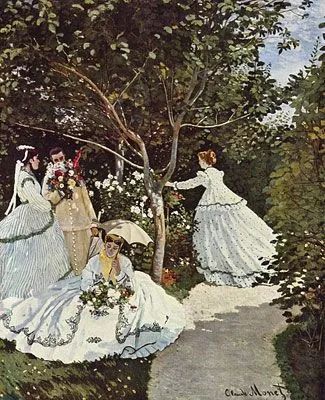
Amy’s hair and little hat perched on top of it are just right for very late 60s or 1870. We could quibble and say her hair should have more lift and be more elaborate, but we do see a large braid and other arrangements at other times. Perhaps she’s still got a bit of the March family belief in not succumbing completely to the extreme whims of fashion, and she’s doing her hair more moderately.

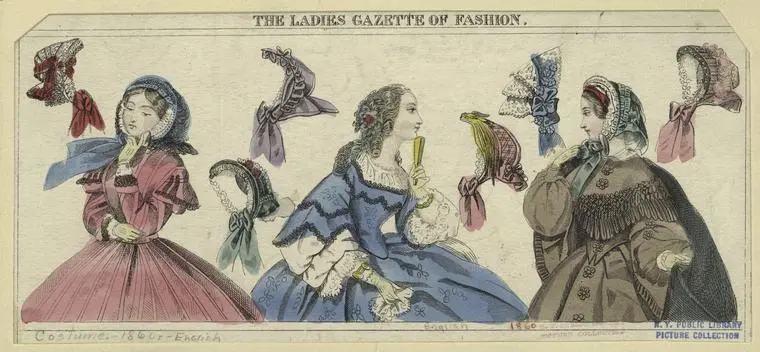

Gerwig’s jumping from present to past accentuates the parallels between events, such as Beth’s first and last illness, Jo’s first and last proposals, and Meg’s ball scene vs. Amy’s. Above, I showed the difference between ball scenes. In Paris, the ball dresses are all dark purples, dark reds, dark blues and blacks. Amy “should” really be in the pale colors suitable to a young unmarried girl, but in service to the design concept of the production, we find her in dark blue with yellow-gold accents. (I had to lighten the picture below so you could see the colors.) This is the kind of inaccuracy I can live with, even though I’m bothered by other violations of what was considered Proper and Appropriate. There’s a good directorial reason for it, it’s not just lazy.
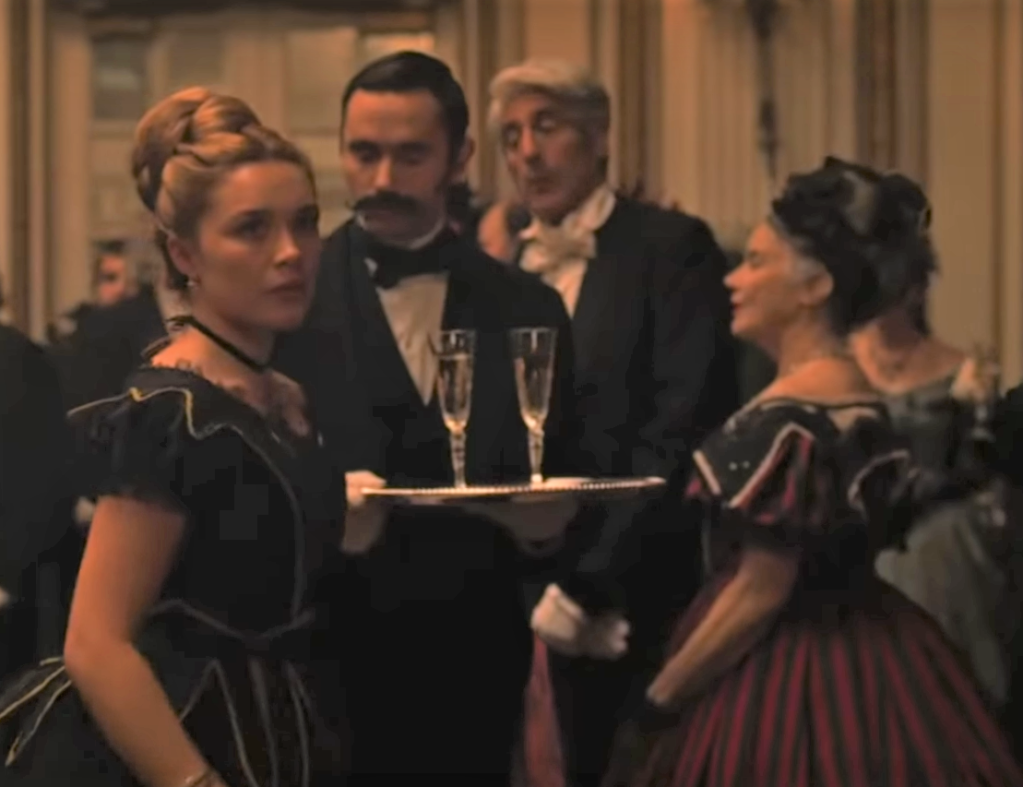
This outfit (below), worn on the lawn when she tells Laurie she’s always loved him, is wonderful. Little peplum skirt which is almost a proto-bustle, a wee hat perched on the head facing forward, hair with some lift, the printed pattern that is period-appropriate. This outfit just makes me happy.

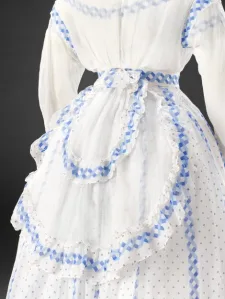
Amy’s little cape was, I read in an interview about the costumes, made by applying the embroidered or woven paisley bits which were cut out from an antique shawl that was falling apart. (I’m not such a purist that I deplore cutting up and reusing something that’s already in bad shape. Hundreds of 19th c shawls are in museums; we can’t and don’t have to save them all.)

Jo, back in New York and Concord, wears mostly dark colors, and sometimes downright homespun-looking textured skirts, with her signature shirts and vests. Jo’s clothes violate strict historical accuracy in a number of ways I’ll enumerate, but it all works for her character. This is a movie, not a historical reenactment. I’m going to be bothered more by some of it and less by others; other costume history folks will forgive more, fewer, or different deviations from what was correct, or appropriate, in the period. For example, Jo’s skirt below has a very homespun look, the weave and dye having an irregularity that machine-woven textiles in this post-industrialized period would not have had.

As I said in my first LW post, shirts were worn as separates by women, but the masculine vests are a Jo thing. It works for the character, but at the time, society (I mean not high society but people in general) had VERY strong views against women appropriating male clothing. When women really DID start wearing men’s style shirts, boater hats, and vests, there was HUGE backlash. But it’s very Jo.

Perhaps illogically, it really bothers me to see her collarbone, and especially her chemise peeking through at times.

I finally found a screenshot of Jo’s trousers under her skirt as she runs through the street (at the beginning after she sells her story):

Not only should she not be showing so much leg, but unless you were Incredibly Peculiar, and were still wearing the Bloomer outfit, as Dr. Mary Walker was, you did not show leg and you did not wear trousers. But again—it works dramatically in the moment.

I’ve read somewhere (and will edit this to add it when I track it down) that Alcott wrote something at some point to suggest women wear trousers as Jo does; perhaps Gerwig was using that; it bothers me a bit to see Jo running in such a non-Victorian way, but…not everyone is versed in mid-19th century etiquette, and most will just grasp that she’s a free spirit, not that people then, seeing her so, seriously would have thought her a fallen woman or a lunatic.
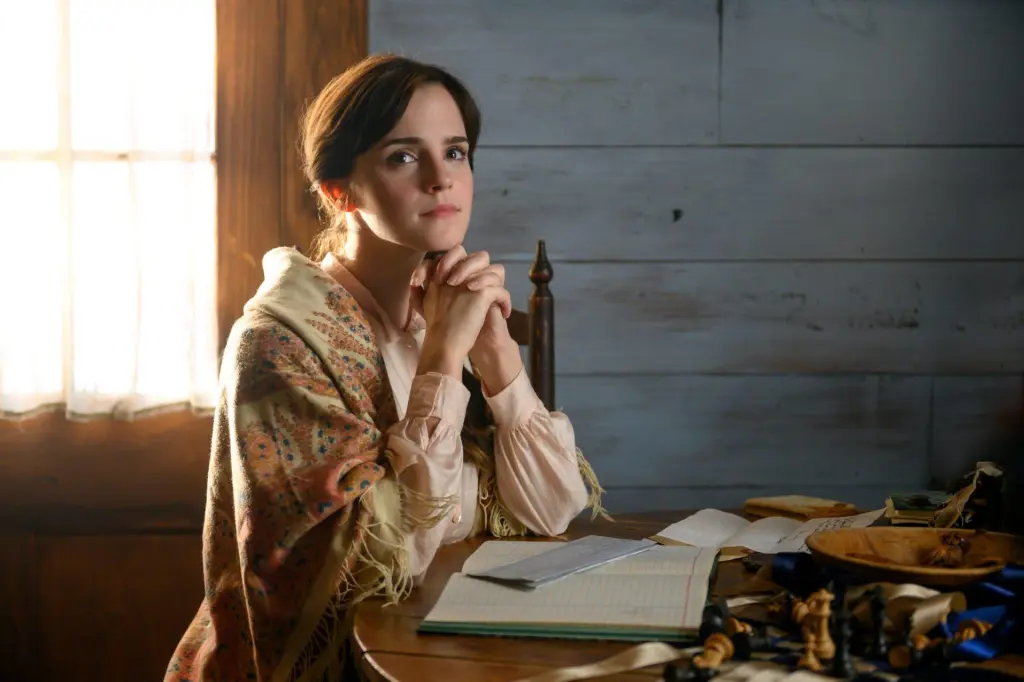
Now, Meg. The trailer (my only source of images til we can stream the movie; I’ll add more when we can) doesn’t include a shot of Meg’s nice printed dress, cape, and little perched-on-head hat like Amy’s which we see when she succumbs to fabric temptation. I’ll just say that OF COURSE she has a nice up to date hat; we know Meg cares about fashion; a new hat is a good way to update your look on a budget. And FINALLY her hair is (usually) put up properly.

I have a problem with Meg’s dress, however. She’s got a lovely shape…for about 1864. We know it’s got to be at least about 1870 by the time Amy is home. Meg–as we know, on a strict clothing budget, but longing to be at least a LITTLE fashionable– would ABSOLUTELY have removed an early 1860s skirt from its bodice, and altered it to flatten it in front, as early as 1866. The dress in the DAR Museum collection below has an 1863 pointed bodice hidden under the skirt’s current waistband; the skirt then would have been full like Meg’s above. As shown below, however, the wearer has reconfigured the skirt from full all around, to flat in front. This works for about 1866-8.
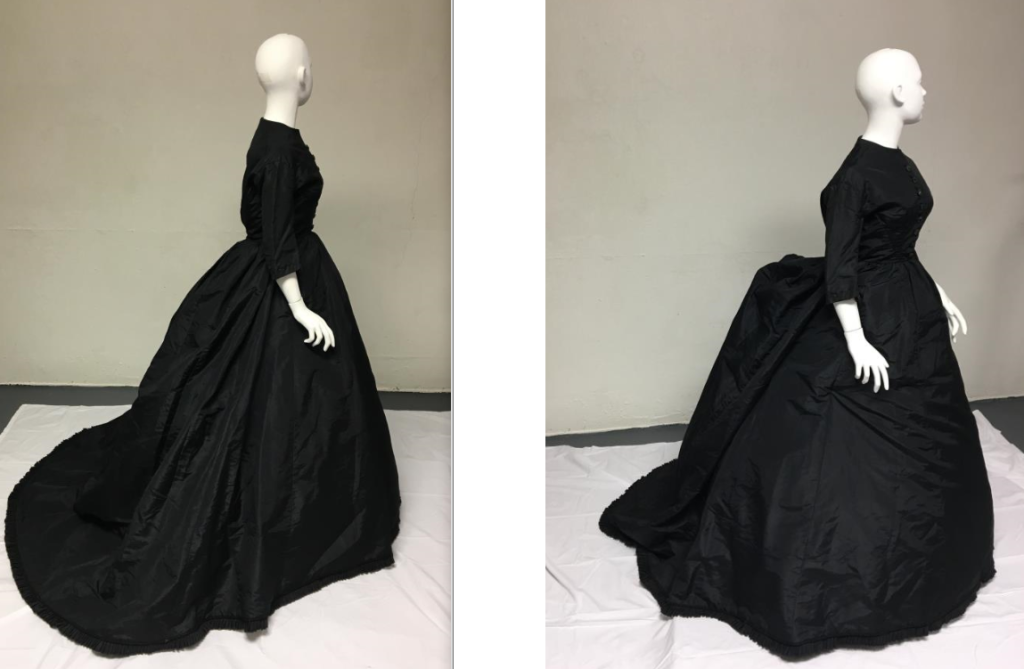
The photo on the right shows how the dress was further updated about 1869-70, by the simple addition of three sets of tape ties in the lining. By tying each set of ties (one higher than the other, at left back, center back, and right back), you create a bustle. Meg could easily, easily, without spending a penny, update all her dresses from the year of her marriage or before, and keep them stylish through about 1873. So it’s disappointing to see her five years out of date.
(More pictures and description of alterations are in the DAR Museum’s online database. Try this link: https://collections.dar.org/RediscoveryProficioPublicSearch/ShowItem.aspx?32504+ and if it doesn’t work, go to collections.dar.org and go to Museum and choose Advanced Search and enter “2010.34.4”–use the quotation marks–into Object Number.)

That said, the plain, solid dress is nicely made for the mid-60s. (I could wish for a bit more color. Surely Meg could have found a practical, pretty print. But that’s a personal preference, not a criticism.)
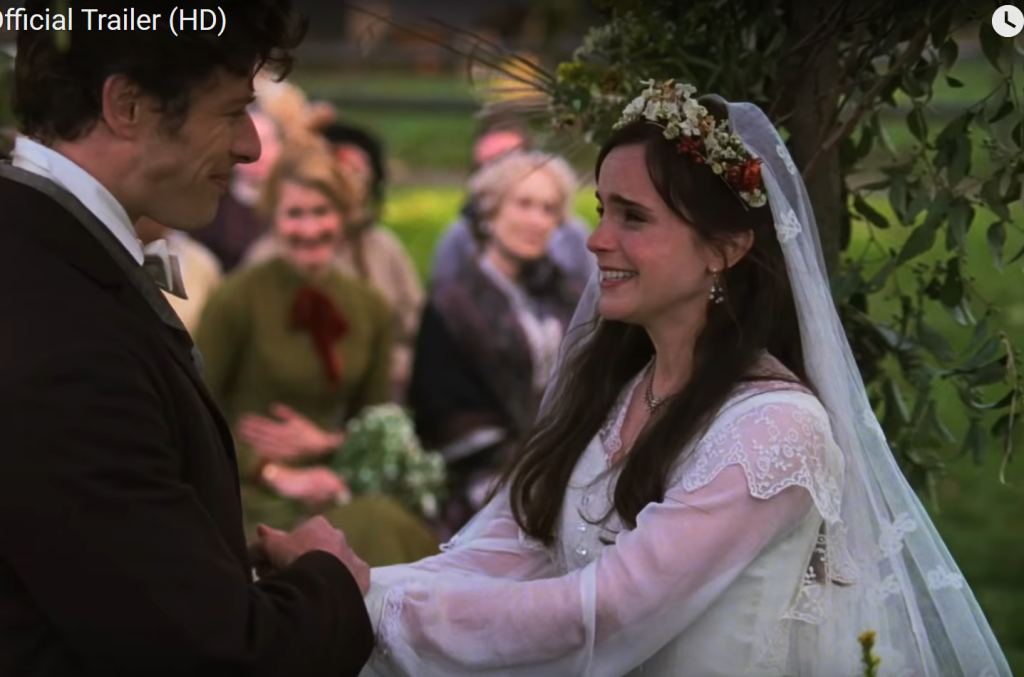
I don’t want to talk about this dress, which is in no way mid- 1860s, and what the HECK is her hair doing DOWN? Marriage more than anything symbolized her transition to adulthood and a new phase of life–she never should have had her hair long and loose like this, but especially not at her wedding. I can’t even. NEXT!

I love this scene, but I’m damned if I know what the hell Jo is wearing. Maybe they’ve rented, and bleached, Anne Hathaway’s jumper from Becoming Jane??
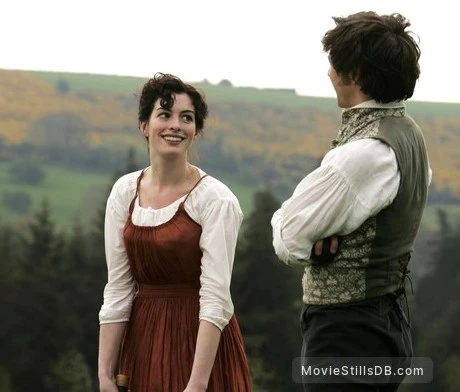
Meg is wearing the same skirt with same trim as we saw back in 1861. (We catch a glimpse as Jo walks past her, and we see her directing students in a fantastical play–a lovely moment, Meg gets to tap into her dramatic talents again! Why am I noticing her skirt! But as I said–she could and would have updated it!)
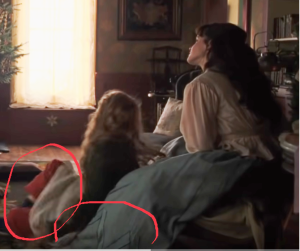
Let me reiterate that I LOVE this movie. As I write (in my nightgown, just like Jo, but minus the 18th century coat!), I have just seen it for a third time. But since I’m a costume person, I notice these things. As you’ve read, I can let a lot of liberties go in the name of telling the story, delineating characters for a modern audience (TO A POINT!), and so on. I’m not into nitpicking just to show off my detailed knowledge of a period. I just think that in some cases, like Meg’s late-period dresses, there was an opportunity missed. Her costumes could have done more to communicate Meg’s character by showing her having updated her old skirt into an 1870 iteration (it’s at least a year later: Amy has a baby; we MUST be in the 70s by now).
That’s what I have to say about the later period clothing. I don’t want to make posts that are too long. I’ll do another where I do all my snarking about what DOES bother me about the inaccuracies, and I have some “deleted scenes,” costumes in the movie which I can show very precise historical sources for, that didn’t make the cut because these are already long enough!
At last! Someone else who is as fed up as I am that with all the money spent on films for costumes and styling no effort at all goes into making sure that hairstyles are appropriate. Instead hair is left long in a way if would never have been in that period. Also young women did not run bare headed through the streets. I can think of at least half a dozen films where this happens. Please try and get it right!
LikeLiked by 2 people
Oh we are not alone! But glad you found my sympathetic blog! Very fed up with lack of headwear and absurd hair. Have you checked out Frock Flicks? They are very funny and scathing about this. They have three writers and churn out way more than I can and of course I just started—my goal is to give a little more text/commentary—but I love their take on historic movies and you prob will too!
LikeLiked by 1 person
No but I will check it out immediately. Sometimes insomnia isn’t all bad!
LikeLike
Very amused by Snark Week on Bangs. I was so glad to finally get mine grown out. It is my life’s ambition to get my hair into a chic, smooth Victorian bun instead of the sad thing I used for ballet classes!
LikeLike
Lol!
LikeLike
ha! I wish you luck! Mine is too wispy to ever grow long or thick enough.
LikeLike
https://louisamay.livejournal.com/19017.html here’s someone who worked out a rough timeline by close reading it says the end where they are celebrating marmee’s birthday is 1877
LikeLike